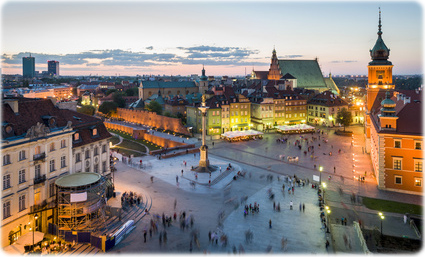
Poland
|
◄ Europe |


Panorama of Warsaw with Old Town.
Square in Krakow.

Geography
Administrative divisions: 16 provinces (wojewodztwa, singular - wojewodztwo); Dolnoslaskie, Kujawsko-Pomorskie, Lodzkie, Lubelskie, Lubuskie, Malopolskie, Mazowieckie, Opolskie, Podkarpackie, Podlaskie, Pomorskie, Slaskie, Swietokrzyskie, Warminsko-Mazurskie, Wielkopolskie, Zachodniopomorskie.
Terrain: mostly flat plain; mountains along southern border. Highest point: Rysy 2,499 m.
Total area: 312,685 km². Coastline: 491 km.
Climate: temperate with cold, cloudy, moderately severe winters with frequent precipitation; mild summers with frequent showers and thundershowers.
Ports and harbors: Gdansk, Gdynia, Gliwice, Kolobrzeg, Szczecin, Swinoujscie, Ustka, Warsaw, Wroclaw.
People
Population: 38.4 million (2018).
Religions: Catholic 87.2% (includes Roman Catholic 86.9% and Greek Catholic, Armenian Catholic, and Byzantine-Slavic Catholic .3%), Orthodox 1.3% (almost all are Polish Autocephalous Orthodox), Protestant 0.4% (mainly Augsburg Evangelical and Pentacostal), other 0.4% (includes Jehovah's Witness, Buddhist, Hare Krishna, Gaudiya Vaishnavism, Muslim, Jewish, Mormon), unspecified 10.8% (2012 est.).
Ethnic groups: Polish 96.9%, Silesian 1.1%, German 0.2%, Ukrainian 0.1%, other and unspecified 1.7% (2011 est.).
Language: Polish (official) 98.2%, Silesian 1.4%, other 1.1%, unspecified 1.3% (2011 est.).
Main source: CIA - The World Factbook.
Poland is an ancient nation that was conceived around the middle of the 10th century. Its golden age occurred in the 16th century. During the following century, the strengthening of the gentry and internal disorders weakened the nation. In a series of agreements between 1772 and 1795, Russia, Prussia, and Austria partitioned Poland amongst themselves. Poland regained its independence in 1918.
Poland became a Soviet satellite state after the World War II, but its government was comparatively tolerant and progressive. Labor turmoil in 1980 led to the formation of the independent trade union "Solidarity" that over time became a political force and by 1990 had swept parliamentary elections and the presidency. A program during the early 1990s enabled the country to transform its economy into one of the most robust in Central Europe, but Poland currently suffers low GDP growth and high unemployment. Solidarity suffered a major defeat in the 2001 parliamentary elections when it failed to elect a single deputy to the lower house of Parliament, and the new leaders of the Solidarity Trade Union subsequently pledged to reduce the Trade Union's political role. Poland joined the European Union in 2004. The capital is Warsaw.

|
Copyright © Geographic Guide - Travel European Continent. |
Gdansk, the capital and largest city of the Pomeranian Voivodeship.
Poland
Jacek Kadaj